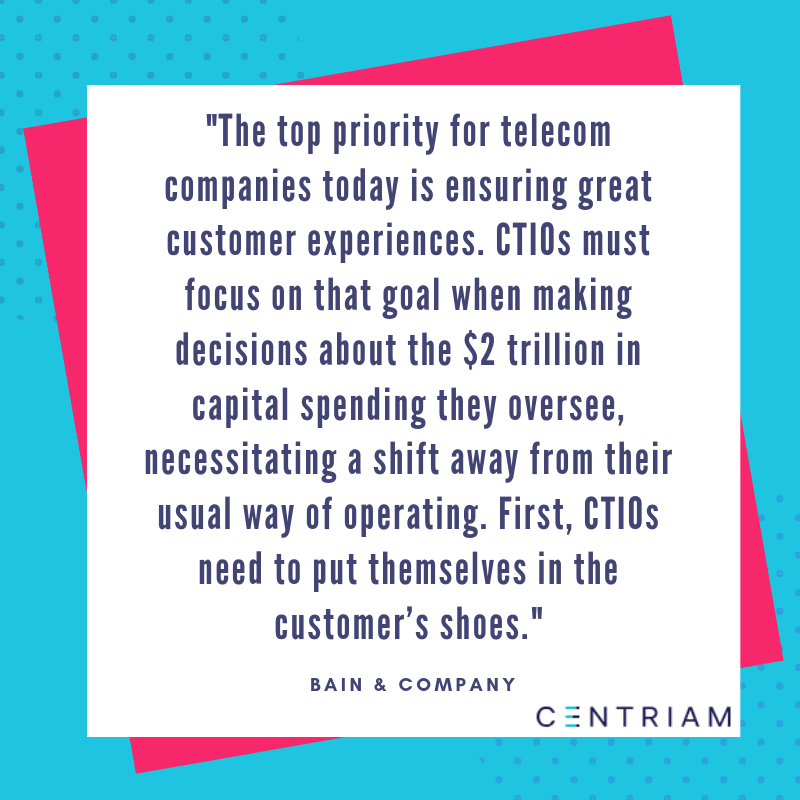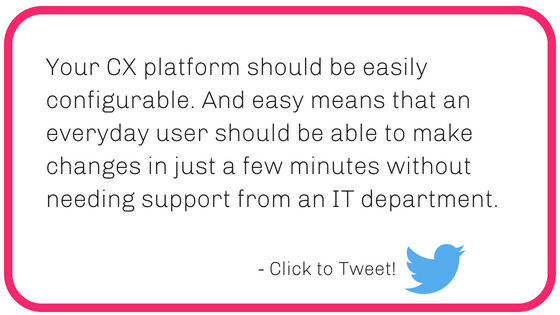1: Customer experience is a telecom growth opportunity
Companies across industries have found opportunities by putting their customers first, and telecom is no exception. The environment has changed — and will continue to change — with increased competition, sophisticated buyers, and rising customer expectations, all contributing to the stress and urgency surrounding telecom growth. But in these tumultuous conditions, a huge opportunity awaits through the simple act of improving customer experience. Here are five reasons why:
- Telecom providers face headwinds.
In addition to the aforementioned challenges, over-the-top (OTT) services, the switch to mobile, the growth of IoT, and the upcoming change to 5G are stress contributors. Telecoms are addressing these concerns in a variety of ways. Competing with OTT is doable and can provide unique opportunities for partnership, as in Comcast’s recent decision to partner with Netflix. Eliminating the competition is always an option as well (e.g., CenturyLink’s acquisition of Level 3). Yet many of these options are both risky and expensive, and we propose that there is a better option.
In a hurry? Email yourself a copy of this CX Guide for Telecoms to read later.
- Churn is a drag on profits.
Annual churn rates vary greatly across telecom, but the Federal Communications Commission (FCC) puts the industry average at 17%. Some turnover is inevitable, and even beneficial, but that number is higher than necessary, as shown in other industries. What would it mean to your bottom line to lower your churn by three or four percent? Bain & Company have estimated that a five percent increase in customer retention produces more than a 25 percent increase in profits. No matter what the precise figure is for your business, there will be immense value.
- Telecoms lag in customer experience.
In fact, customer experience scores are worse in telecom than any other industry, according to research by Temkin and Forrester. In addition, ASCI reports that telecom customer experience is getting worse. ISP customer satisfaction has declined to its nadir, while satisfaction for subscription TV is at a 12-year low. We don’t mention this to be negative, but instead to point out the large opportunity here for improvement. Customers don’t leave just because they can; they leave because they expect to get a better experience.

- Service centers don’t meet expectations.
Digging further into the CX reports from ASCI, Forrester, and Temkin suggests that customer expectations are being met for features such as video quality and channel selection, but not for care center/service center help. This is good news! The hard work of modernizing networks and curating content has been done. Devoting resources to improving your service center interactions is your next big growth avenue, and it is completely obtainable if you have the right tools and technology in place.
- Improve CX to improve the bottom line.
Trying to meet customer expectations in an ever-changing landscape might seem difficult. But it’s worth it: analysis from McKinsey and Forrester suggest it is the largest opportunity for growth in the telecom industry. The biannual CMO survey included 250 marketers from the industry, who collectively agreed that customer experience is the key to future growth.
In a comparative analysis relating customer experience and growth, CX leaders outgrew CX laggards an average of fivefold. Specifically, in the telecom space, AT&T surpasses Comcast in every customer experience metric. As a result, there has been a stark contrast in their growth, with AT&T subscriptions growing over 30 percent for internet and over 13 percent for video. Meanwhile, Comcast subscriptions grew 6.5 percent for internet, and actually shrank for video.
2: How to select the right technology for your telecom CX program
When considering which technology is the right option to power your customer experience program, it helps to remember the “three P’s”: People, Platform, and Process. Luckily in telecom, the people are usually covered. You already have a customer care center, field technicians, and maybe even retail employees.
With the first “P” taken care of, the focus shifts to Platform and Process. Here, process refers to the operations created or modified to support noticeably better customer experiences, while platform refers to the technology in place to facilitate those new and enhanced processes.
In this section, we’ll arm you with additional questions to ask to help assess your customer experience platform options in three key areas. In the following chapter, we will address the third P: Process.
We believe that in order to deliver noticeably better CX, you need a technology platform that is more than a survey tool and different than a CRM tool. It should enable you to easily ask, assess, and act. But how do you evaluate a CX platform? We suggest asking these three questions:
- Can you personally set up and manage the platform with minimal training?
- Will the platform help your organization take action?
- Will the platform grow with your program over time … without growing pains?

1. Platform Management and Setup
Your platform should be easily configurable. And when we say easy, we mean that an everyday user should be able to make changes in just a few minutes without needing support from an IT department. You may choose to use a service provider to support your program, which is great. However, you shouldn’t be forced to rely entirely on that service provider because your platform is so challenging to use. For example, you should not need a three-day certification period simply to modify a survey.
To help you assess your current tool or future considerations, think about the following areas:
- Can you easily bring new customer data into the platform?
- Can you create a survey? And once created, can you determine who the survey goes to, on which channel, and at which time?
- Can you obtain the data output? Can a business user easily set up reports inside the platform? Can the Business Intelligence team export the data they need for their dashboarding tool of choice?
2. Actionable, Meaningful Data
Your company does not need more information for information’s sake. But it is probably hungry for data that encourages actions and incites proactive change. To assess a platform’s ability to provide you with the data you need, use the following five questions as a guide:
- Does it help you send specific customer feedback to the right person for follow up? This is also referred to as “closing the loop.”
- Can you create a new campaign or ad-hoc survey based on all customer data in the platform?
- Can you leverage a combination of verbatim comments and customer attributes to determine the appropriate follow up? For example, if a promoter has negative sentiment about billing, can they automatically be sent an email with a link to an interactive video that explains their bill?
- Can you add follow-up actions over time? For example, divide the negative billing sentiment rule in two: gold customers receive a call, while all others are sent an email.
- Can you change follow-up actions in real time? To continue with the previous example, you should be able to make a change to your negative billing sentiment in minutes versus days while the program is live.

3. Program Scalability Over Time
Your CX program will grow in breadth over time, whether it be the number of touchpoints you have, the markets or channels included, or even the products covered. And with that, likely the depth will also grow, such as the level of personalization, the survey versions, or the number of routing rules. Keeping that end in mind, you want a platform that is built to be configurable and expanded over time, not customized to your current state or even worse, something that requires professional services to “re-customize” in order to support your growth. If you are viewing a product demo, ask to be shown the following:
- Does your platform have the ability to expand information available over time, without having to set up a new data feed, so you can perform more detailed analyses? For example, an installation touchpoint by modem model or by new vs. refurbished customer hardware.
- How does your platform expand to include more touchpoints (each new touchpoint being triggered by a new source data)? For example, if you want to add an outage recovery or network upgrade survey.
- Does your platform allow for new data to further personalize touchpoints? For example, personalize existing surveys to improve feedback quality with data such as service visit date, type of service performed, call disposition, etc.
- Does your platform make it easy to add new users and selectively permission what they can do on the platform? For example, if you wanted to make select survey data available to a network analyst, provide editing and data rights for all surveys to a CX researcher, while only granting permission to modify recovery offers for a program manager.
3: Where to focus your telecom CX program for best success
Are you feeling overwhelmed? There are so many potential focus areas for telecoms. But if you focus your platform and processes around customer experience, you can see success. Let’s break it down into three key areas that warrant your attention.
What really works: focusing on customer needs.
Increasing first call resolution:
Recently a telecom in Spain shared their results where an over 30 percent increase in FCR led to more than a 50 percent decrease in the number of calls. This is much different than focusing on cost per call. Focusing on cost per call will quickly lead you down the path of hiring cheaper and less qualified agents with higher turnover. This path actually leads to more calls by frustrated customers, laying the foundation for increased churn and increasing demand for expensive service visits (a.k.a. “no fault found” truck rolls). Just like positive momentum, negative momentum can also build if you have the wrong approach.
One potential area to start your FCR reduction efforts is better resolution of billing questions. Ideally, this would go hand in hand with the simplifying the bill itself. Centriam found that telecom customers with billing questions were more likely to call again the next month and the month after that with more billing questions. This issue-specific repeat rate was 56 to 120 percent higher than other call reasons. For this company, the monthly billing cycle had become a recurring trigger.

Providing prompt recoveries fuel the service recovery paradox:
As a telecom, your most loyal customers are not the customers who have never had an issue; they are the customers who have had an issue that you promptly resolved. These customers have experienced the good or excellent service you delivered and it shows in their perceptions of and loyalty to your company.
For example, Centriam built a key driver model for one mobile operator that showed a 12 point increase in NPS for customers who had an issue with a call center that was resolved in one call (compared to a customer with no issues). However, if the customer needed to make a second call, the NPS score dropped noticeably below the baseline (again, compared to a customer with no issues). The conclusion is clear: not only does great service resolution contain costs by raising FCR, it also contributes to future revenue streams through higher customer loyalty.
Adding customer feedback as a component of budgeting decisions:
Telecom has the most complex investment decisions of any industry. Bain compared the concentration of capital investment against capital intensity in 17 industries and found that in no other vertical do finance executives face as severe a challenge in effectively allocating significant capital investment across such a broad range of assets and categories.
Despite this complexity, many telecoms do not sufficiently quantify the impact of these investments on customer experience. If you have budget to replace one hundred network nodes with a newer model, which ones should you replace? Obviously, current node load and performance are factors, but are they the only ones? How will upgrading to a new node affect the customer experience for the few hundred customers attached to that node? How will it impact retention? By scoring nodes based on multiple metrics, including network performance and customer perceptions, Centriam has seen that poor performing nodes can have three times the monthly churn rate and generate seven times as many calls to the call center as high performing nodes. By focusing more on nodes (or cell towers, satellites, etc.) with a bigger impact on customer experience, telecoms can drive improved customer experience within their existing budgets.

4: How to get started with CX for telecoms
Don’t let starting a new customer experience initiative intimidate you. It’s easier than you might think if you break it down. Although it can be tempting to dive in, you don’t need to boil the ocean in order to start seeing results. It is just fine to start small with one product or one touchpoint (like contacting a call center) or with one customer episode (like creating a follow-up survey after new internet installations) and expand from there. Regardless of whether you start small or not, your first program should have three critical parts.
Part 1 – Ask: Understand your customer.
You need to start by understanding the customer relationship and you do that by asking! However, customers don’t want to take a long, non-personalized survey. Feedback collection should be broken up into easy, fast pieces by establishing triggered surveys after key touchpoints like a new service installation, extended service outage, or after reviewing their first bill. You can also build in triggers for more common behaviors (monthly bill, visiting the mobile app, etc.), but it’s important not to go overboard: do not set up a trigger for every action, every time. For more frequent common behaviors, consider following up about twice per year.
Regardless of frequency and the specific event trigger, you should keep surveys short and simple to keep survey response rates high. Leveraging the information you have on the customer will help you personalize the survey. Personalizing the survey based on the data you have available will help keep customers engaged. Think beyond just customer name with specifics like the date of the event or what service was performed.
To make the “Ask” effective, select one KPI (e.g., NPS, CSAT, customer effort) and support it with several key driver questions like, “Was the technician friendly? Did the technician seem knowledgeable?”, etc. Also, make the surveys easy by utilizing email and text, and ensure they are mobile friendly. This will increase the response rate because customers can participate anywhere and at their own convenience.

Part 2 – Act: Close the loop.
If you uncover that a customer’s response is not up to standard when soliciting feedback, quickly follow up with that customer and close the loop. There are several ways to close that loop. You could insert business rules as they make sense. For example, maybe high value customers (small businesses or “triple-play” customers), get a personal call after major changes like a modem upgrade.
As always in customer experience, speed is key to customer satisfaction. When Centriam asked customers about a recent problematic experience, four out of seven said they expected follow up within a day. With speed being at the forefront of customer needs, this is often a change you can make quickly and see tangible results within weeks.
Sound too good to be true? To track improvements for your pilot program and set up a control group — don’t follow up with a random 20 percent and monitor customer behavior across the board. Are you seeing lower service call rates, higher usage, better retention, or increased cross-sell among those you followed up with? You just might be surprised at the results.
Part 3 – Advance: Expand and improve your program over time.
Your customer experience program should be an ongoing iterative process. Expanding and improving the program over time is critical to sustained improvements. Results should be continually monitored as part of this ongoing improvement. If a rock-solid measurement is needed, we recommend holding out a control group for further verification and validation. In telecoms, a big part of the financial benefit is often through increased retention, but detecting these changes take time. Set the expectation internally that it will take several months to see measurable results in this metric.
As your program continues, it’s important to add additional touchpoints over time. For help determining which touchpoints to start with, consider these three rules:
- Common: Touchpoints that include more customers offer more chance to collect feedback. Hold off on building a customer experience program around a touchpoint that affects one percent of subscribers until more common touchpoints are covered.
- Emotional: Prioritize touchpoints that have the power to delight or annoy. These are the touchpoints which have the ability to remove frustrating roadblocks and create memorable experiences.
- Identifiable: Touchpoints that you have that are backed by data and that can trigger a survey. Otherwise you have no way to reliably ask about the experience.
When we apply these three rules to telecoms — common, emotional, identifiable — we often see the need to expand to cover events such as installing a new service or contacting the call center. Here you could consider focusing on certain dispositions that are more likely to be emotional. Once all the basic events are covered, you can expand your program to cover other rarer items such as setting up auto pay, billing disputes, or change of address. While these events are not as common, they often are more emotional: they have more opportunity both to delight and to annoy your telecom customers.

Centriam is a customer experience management platform built to better manage and improve customer relationships. Centriam redefines how telecoms manage their customer experience efforts.
Our platform enables you to track customer behavior and collect customer feedback across channels. It empowers you to analyze and act on all data and measure the impact of customer experience campaigns on customer behavior. Centriam is designed for customer experience and marketing professionals who want to delight their customers.







